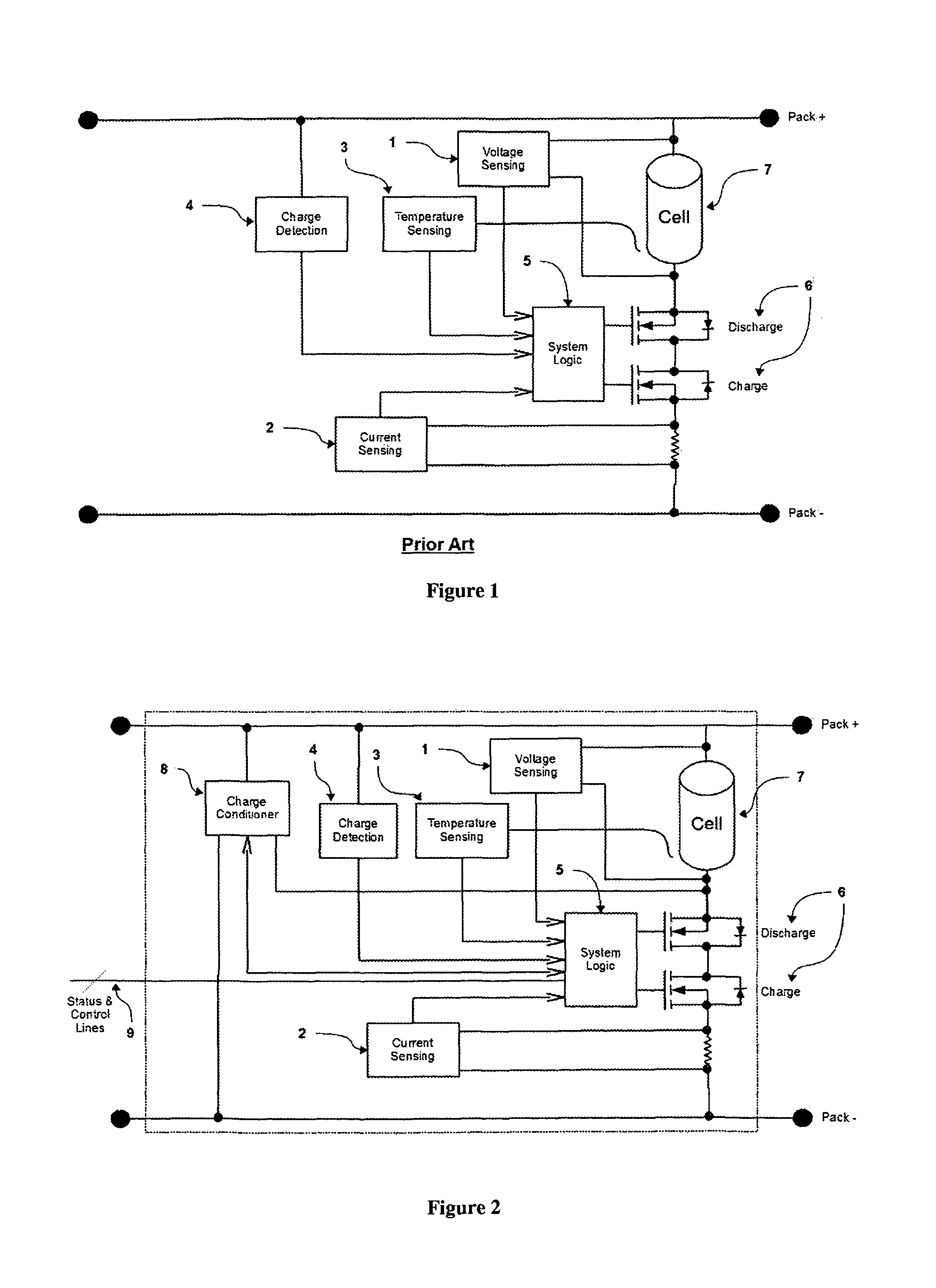Battery cell protection and conditioning circuit and system
a battery cell and circuit technology, applied in the field of battery cell protection and conditioning circuit and system, can solve the problems of new safety, performance and efficiency, early termination of overall battery discharge operation, and far presented serious safety and cost drawbacks, and achieve the effects of optimizing the performance enhancing the safety of the battery pack, and reducing the cos
- Summary
- Abstract
- Description
- Claims
- Application Information
AI Technical Summary
Benefits of technology
Problems solved by technology
Method used
Image
Examples
first embodiment
[0012]Refer to FIG. 1, which illustrates the functional blocks of a traditional lithium-ion battery-protection circuit. The protection circuit typically includes a voltage sensor [1] that will detect an over-voltage condition during charging, or an under-voltage condition during discharging or when in storage. A current sensor [2] monitors current through the battery cell [7] in order to prevent discharge or charge currents from exceeding specific safety values. A temperature sensor [3] is used during charging to detect cell overheating. A charge-detection circuit [4] detects the presence of a charger in order to initiate and control the charging process. All of this information is collected and processed in the system-logic module, which controls a set of switches [6] that can turn open or close the charging or discharging current path. This protection circuit is currently used as a stand-alone unit that act unsupervised in situations that threaten battery-pack safety.
[0013]In mult...
second embodiment
ng and Conditioning Battery Cells
[0019]This embodiment encompasses a system for charging and conditioning the cells in a battery bank. The battery bank comprises a plurality of cells in connected in series, each of the plurality of cells defining a respective condition of charge. The system has an external constant-voltage / constant-current (CV / CC) battery charger. Each individual cell in the battery bank has a cell-protection circuit, with each of cell-protection circuits having a charge detector, a voltage sensor, a sensor for detecting charging current and discharging current, and switches for opening or closing the discharging or charging current path through the associated individual battery cell. Each cell-protection circuit further comprises a charge conditioner, with the charge conditioner being a constant-voltage-limited-current charger that is externally controlled and used when the associated battery cell reaches a predetermined state of charge from the external CV / CC batt...
third embodiment
ing and Conditioning Battery Cells
[0034]This embodiment encompasses a method for charging and conditioning the cells in a battery bank. The battery bank comprises a plurality of cells connected in series, each of the plurality of cells defining a respective condition of charge. The method comprises the step of providing a system having an external constant-voltage / constant-current (CV / CC) battery charger. Each individual cell within the battery bank has a cell-protection circuit, with each of the cell-protection circuits having a charge detector, a voltage sensor, a sensor for detecting charging current and discharging current, and switches for opening or closing the discharging or charging current path through said associated individual battery cell.
[0035]The method further comprises the step of providing in each cell-protection circuit a charge conditioner, with the charge conditioner being a constant-voltage-limited-current charger that is externally controlled and used when said...
PUM
 Login to View More
Login to View More Abstract
Description
Claims
Application Information
 Login to View More
Login to View More - R&D
- Intellectual Property
- Life Sciences
- Materials
- Tech Scout
- Unparalleled Data Quality
- Higher Quality Content
- 60% Fewer Hallucinations
Browse by: Latest US Patents, China's latest patents, Technical Efficacy Thesaurus, Application Domain, Technology Topic, Popular Technical Reports.
© 2025 PatSnap. All rights reserved.Legal|Privacy policy|Modern Slavery Act Transparency Statement|Sitemap|About US| Contact US: help@patsnap.com



